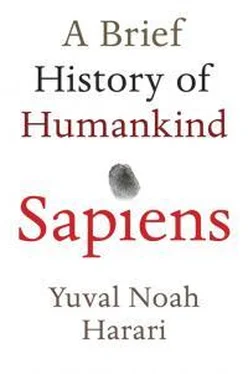The first commercial train service began operating between Liverpool and Manchester in 1830. Ten years later, the first train timetable was issued. The trains were much faster than the old carriages, so the quirky differences in local hours became a severe nuisance. In 1847, British train companies put their heads together and agreed that henceforth all train timetables would be calibrated to Greenwich Observatory time, rather than the local times of Liverpool, Manchester or Glasgow. More and more institutions followed the lead of the train companies. Finally, in 1880, the British government took the unprecedented step of legislating that all timetables in Britain must follow Greenwich. For the first time in history, a country adopted a national time and obliged its population to live according to an artificial clock rather than local ones or sunrise-to-sunset cycles.
This modest beginning spawned a global network of timetables, synchronised down to the tiniest fractions of a second. When the broadcast media – first radio, then television – made their debut, they entered a world of timetables and became its main enforcers and evangelists. Among the first things radio stations broadcast were time signals, beeps that enabled far-flung settlements and ships at sea to set their clocks. Later, radio stations adopted the custom of broadcasting the news every hour. Nowadays, the first item of every news broadcast – more important even than the outbreak of war – is the time. During World War Two, BBC News was broadcast to Nazi-occupied Europe. Each news programme opened with a live broadcast of Big Ben tolling the hour – the magical sound of freedom. Ingenious German physicists found a way to determine the weather conditions in London based on tiny differences in the tone of the broadcast ding-dongs. This information offered invaluable help to the Luftwaffe. When the British Secret Service discovered this, they replaced the live broadcast with a set recording of the famous clock.
In order to run the timetable network, cheap but precise portable clocks became ubiquitous. In Assyrian, Sassanid or Inca cities there might have been at most a few sundials. In European medieval cities there was usually a single clock – a giant machine mounted on top of a high tower in the town square. These tower clocks were notoriously inaccurate, but since there were no other clocks in town to contradict them, it hardly made any difference. Today, a single affluent family generally has more timepieces at home than an entire medieval country. You can tell the time by looking at your wristwatch, glancing at your Android, peering at the alarm clock by your bed, gazing at the clock on the kitchen wall, staring at the microwave, catching a glimpse of the TV or DVD, or taking in the taskbar on your computer out of the corner of your eye. You need to make a conscious effort not to know what time it is.
The typical person consults these clocks several dozen times a day, because almost everything we do has to be done on time. An alarm clock wakes us up at 7 a.m., we heat our frozen bagel for exactly fifty seconds in the microwave, brush our teeth for three minutes until the electric toothbrush beeps, catch the 07:40 train to work, run on the treadmill at the gym until the beeper announces that half an hour is over, sit down in front of the TV at 7 p.m. to watch our favourite show, get interrupted at preordained moments by commercials that cost $1,000 per second, and eventually unload all our angst on a therapist who restricts our prattle to the now standard fifty-minute therapy hour.
The Industrial Revolution brought about dozens of major upheavals in human society. Adapting to industrial time is just one of them. Other notable examples include urbanisation, the disappearance of the peasantry, the rise of the industrial proletariat, the empowerment of the common person, democratisation, youth culture and the disintegration of patriarchy.
Yet all of these upheavals are dwarfed by the most momentous social revolution that ever befell humankind: the collapse of the family and the local community and their replacement by the state and the market. As best we can tell, from the earliest times, more than a million years ago, humans lived in small, intimate communities, most of whose members were kin. The Cognitive Revolution and the Agricultural Revolution did not change that. They glued together families and communities to create tribes, cities, kingdoms and empires, but families and communities remained the basic building blocks of all human societies. The Industrial Revolution, on the other hand, managed within little more than two centuries to break these building blocks into atoms. Most of the traditional functions of families and communities were handed over to states and markets.
The Collapse of the Family and the Community
Prior to the Industrial Revolution, the daily life of most humans ran its course within three ancient frames: the nuclear family, the extended family and the local intimate community. *Most people worked in the family business – the family farm or the family workshop, for example – or they worked in their neighbours’ family businesses. The family was also the welfare system, the health system, the education system, the construction industry, the trade union, the pension fund, the insurance company, the radio, the television, the newspapers, the bank and even the police.
When a person fell sick, the family took care of her. When a person grew old, the family supported her, and her children were her pension fund. When a person died, the family took care of the orphans. If a person wanted to build a hut, the family lent a hand. If a person wanted to open a business, the family raised the necessary money. If a person wanted to marry, the family chose, or at least vetted, the prospective spouse. If conflict arose with a neighbour, the family muscled in. But if a person’s illness was too grave for the family to manage, or a new business demanded too large an investment, or the neighbourhood quarrel escalated to the point of violence, the local community came to the rescue.
The community offered help on the basis of local traditions and an economy of favours, which often differed greatly from the supply and demand laws of the free market. In an old-fashioned medieval community, when my neighbour was in need, I helped build his hut and guard his sheep, without expecting any payment in return. When I was in need, my neighbour returned the favour. At the same time, the local potentate might have drafted all of us villagers to construct his castle without paying us a penny. In exchange, we counted on him to defend us against brigands and barbarians. Village life involved many transactions but few payments. There were some markets, of course, but their roles were limited. You could buy rare spices, cloth and tools, and hire the services of lawyers and doctors. Yet less than 10 per cent of commonly used products and services were bought in the market. Most human needs were taken care of by the family and the community.
There were also kingdoms and empires that performed important tasks such as waging wars, building roads and constructing palaces. For these purposes kings raised taxes and occasionally enlisted soldiers and labourers. Yet, with few exceptions, they tended to stay out of the daily affairs of families and communities. Even if they wanted to intervene, most kings could do so only with difficulty. Traditional agricultural economies had few surpluses with which to feed crowds of government officials, policemen, social workers, teachers and doctors. Consequently, most rulers did not develop mass welfare systems, health-care systems or educational systems. They left such matters in the hands of families and communities. Even on rare occasions when rulers tried to intervene more intensively in the daily lives of the peasantry (as happened, for example, in the Qin Empire in China), they did so by converting family heads and community elders into government agents.
Читать дальше



![Юваль Ной Харари - Sapiens. Краткая история человечества [litres]](/books/34310/yuval-noj-harari-sapiens-kratkaya-istoriya-cheloveche-thumb.webp)





![Юваль Ной Харари - 21 урок для XXI века [Версия с комментированными отличиями перевода]](/books/412481/yuval-noj-harari-21-urok-dlya-xxi-veka-versiya-s-ko-thumb.webp)


